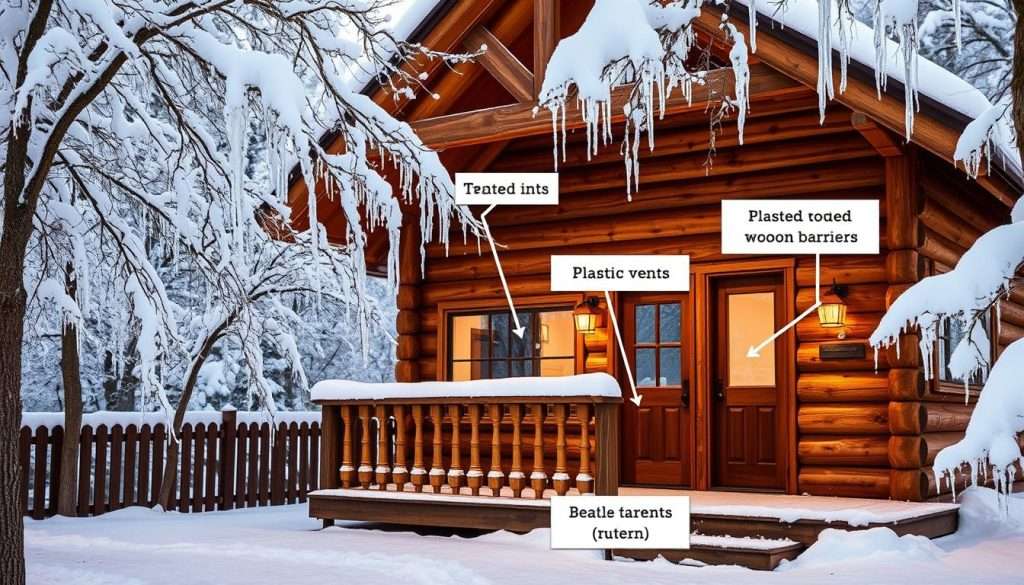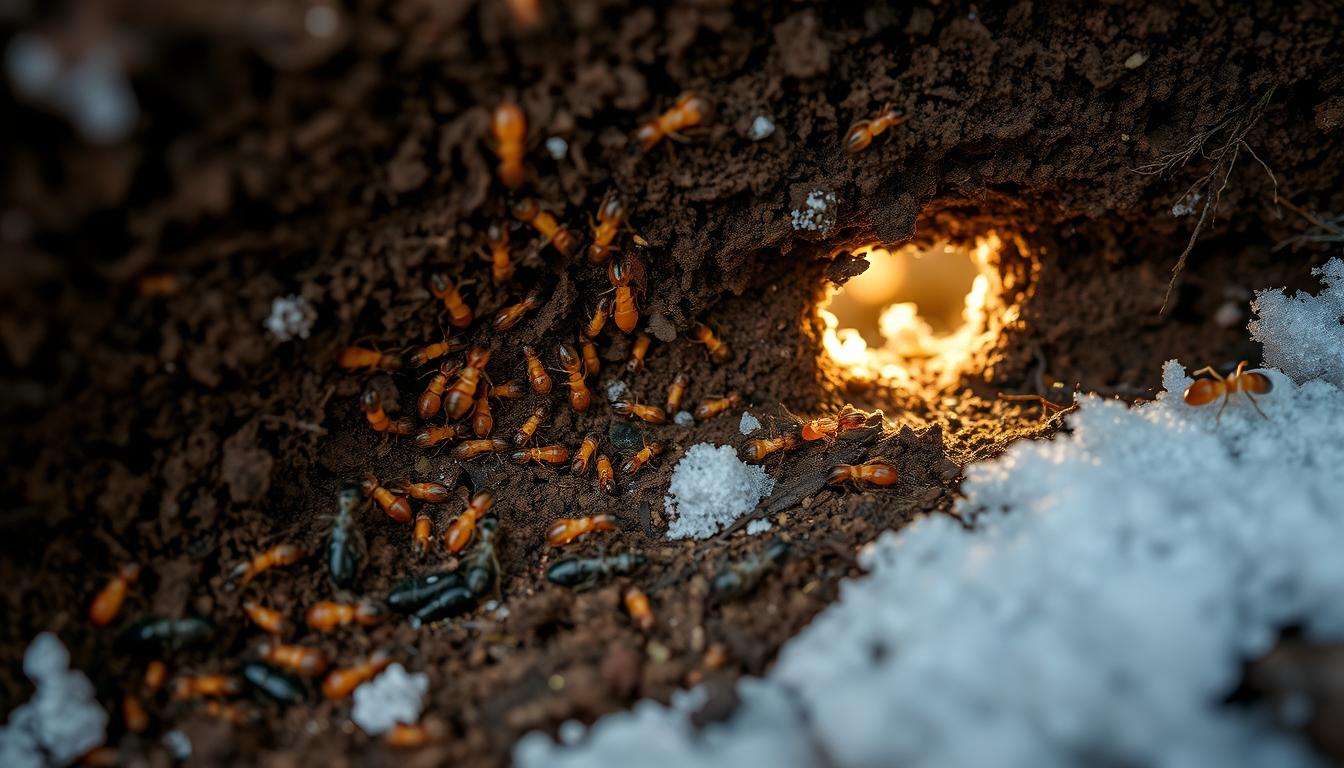Homeowners might think winter stops pests, but termites keep going. They don’t sleep like we do; they slow down instead. Termites are still active, even when we can’t see them.
Researchers found that termites act differently in cold weather. This is true for *Formosan*, *subterranean*, *dry wood*, and *damp wood* termites. Knowing this helps us stay alert.
In places like Florida and San Diego, termites are still a big problem in winter. Subterranean termites might even swarm at winter’s end. This means we need to check our homes often and take action.
To keep your home safe from termites, you need to know how they behave. We’ll talk about their winter habits, how to spot them, treatments, and ways to prevent them.
Key Takeaways
- Termites remain active in winter, adjusting their metabolism to survive the cold.
- Different species exhibit unique behaviors during colder months.
- Subterranean termites may swarm as winter draws to a close.
- Regular pest control and inspections help prevent significant damage.
- Winter months offer a good opportunity for pest inspections.
Understanding Termite Behavior in Cold Weather
Termites live in colonies with different roles like workers, soldiers, and reproductives. Knowing how they act in cold weather helps us fight infestations. Unlike many insects, termites don’t fully hibernate. Their metabolism just slows down.
Subterranean termites dig deeper to avoid cold. Drywood and dampwood termites like to nest in wooden places, especially if they’re warm. This shows how adaptable and warm-loving termites are. If they find a warm, humid home, they might stay active.
When it’s very cold, termites hide and wait for warmer soil. Snow helps keep them safe by insulating the ground. Termites can eat wood all day, even in winter, if it’s warm enough. This means we must always watch for signs of termites.
Ignoring termites can harm your home’s wood, damaging beams and walls. Homeowners should check for termites often, especially in winter. Keeping trees away and treating wood with borate-based sealants helps protect your home. It’s also important to get termite inspections every 12 months, especially in risky areas.
Are Termites Active in Winter
It’s important to know how termites act in winter. Many wonder if termites swarm in winter. Unlike other insects, termites don’t fully stop moving. They might slow down but still stay active.
Termite Activity and Temperature Changes
Termites love warm weather, usually around 75 degrees Fahrenheit. Cold weather slows them down but they keep going. They can still eat and make more termites.
Homeowners should know termites can damage homes a lot. This damage costs over $5 billion each year.
Colony Hibernation vs. Activity
Termite colonies don’t really hibernate. They keep working but at a slower pace in winter. Subterranean termites might even come out to find warmth in walls.
Early signs of termites can show up, even when it’s cold. These signs might look like pepper grains.
It’s key to act early against termites in winter. Using Termidor can help fight them. Also, getting help from pest control services can spot problems early.

| Factors | Impact on Termite Activity |
|---|---|
| Temperature | Termites thrive in warm conditions, slow down in cold |
| Season | Active year-round, more monitoring needed in winter |
| Infestation Signs | Droppings, potential damage in walls |
| Treatment Options | Termidor and professional inspections effective |
Types of Termites and Their Winter Activity
Knowing about different termite types helps prevent them in winter. Each type acts differently in cold months. We’ll look at two main types: subterranean and drywood/dampwood termites.
Subterranean Termites
Subterranean termites are very destructive because they tunnel underground. They can be active in winter if it’s not too cold. In warm winter areas, they keep eating and breeding without pause. To stop them in winter, do these things:
- Check around foundation walls for shelter tubes.
- Keep your place dry, as termites like moisture.
- Store firewood high and far from your home.
Drywood and Dampwood Termites
Drywood and dampwood termites live in the wood they eat. They are a big risk, especially where there’s a lot of wood. They don’t make shelter tubes, so finding them is hard. In winter, they might:
- Eat wood in your home, even when it’s cold.
- Show signs like small fecal pellets that look like pepper.
- Damage your home if you don’t catch them.
Storing firewood right and checking often can help fight these termites. In winter, sealing off entry points helps keep your home safe. Knowing how these pests act helps you protect your home.
| Termite Type | Winter Activity | Prevention Tips |
|---|---|---|
| Subterranean Termites | Active in warm winter months; create shelter tubes | Inspect foundations; eliminate moisture sources |
| Drywood Termites | Feed on wood year-round; push feces out | Store firewood properly; conduct regular inspections |
| Dampwood Termites | Active in damp wood; may infest near sources of moisture | Keep wood debris clear; reduce moisture around structures |
Signs of Termite Presence During Winter
It’s important to know the termite signs in winter for homeowners. Termite activity slows down in cold weather, but signs can still appear. Spotting termite damage early can save you from expensive fixes and big renovations. Here are key things to check during winter.
Identifying Termite Damage
Termites often hide until they cause a lot of damage. Look for these signs:
- Hollow-sounding wood: Tap on wood gently; a hollow sound means damage inside.
- Small holes: Tiny holes in wood could mean termites are there.
- Frass: Termite droppings look like sawdust or small pellets near infested spots.
Visual Clues of Infestation
Even without swarming, winter can show signs of termites:
- Mud tubes: Subterranean termites make mud tubes to reach food while staying warm.
- Discarded wings: Clusters of wings near windows or doors mean swarmers looked for new homes.
- Visible sagging or weak wood: Sagging or weak wood could hide a bigger problem.
Regular checks are key, even in winter, as termites might only show up after a while. Watching for these termite signs in winter helps catch problems early. This way, you can avoid big damage.
Winter Termite Treatment Options
Winter brings special challenges for homeowners fighting termites. It’s key to know your options for termite control. You can pick professional help or try DIY methods to keep your home safe.
Professional Pest Control Services
For serious termite problems, getting help from a pest control pro is wise. Companies like Urban Desert Pest Control offer custom solutions. Their experts use detailed plans that often work better than DIY methods.
- Comprehensive inspections: A thorough inspection can reveal the extent of the infestation.
- Spot treatments: This economical option targets contained infestations effectively, eliminating all members of the colony.
- Foam perimeter treatments: Ideal for new constructions, this method expands to fill gaps and kills termites on contact.
- Subterranean treatments: These involve drilling into slab joints to chemically treat underground colonies, providing comprehensive coverage for protection.
DIY Termite Control Measures
For small problems or to prevent them, DIY methods can be good. Homeowners can protect their homes from termites in winter.
- Seal cracks and entry points: Prevent termites from entering by sealing any gaps in your home’s foundation, windows, and doors.
- Reduce moisture levels: Termites love damp places. Look for leaks and make sure crawl spaces and basements are well-ventilated.
- Apply chemical barriers: Regularly treat your home’s perimeter with termite deterrents to discourage infestations.
Choosing the right winter termite treatment is important. While DIY can help with small issues, big problems need a pro for the best fix.
Preventative Measures Against Termite Infestations
Termite infestations can be a big worry, even in winter. It’s important to act early. Start by winterizing against termites. This means sealing your home, ensuring good drainage, and keeping air moving. These steps help keep moisture down, which termites don’t like.
Winterizing Your Home
To winterize your home well, follow these steps:
- Seal cracks and gaps in your foundation, walls, and roof.
- Ensure proper drainage around your property to prevent moisture accumulation.
- Keep firewood and other wood debris away from your home.
- Maintain good ventilation in attics and crawl spaces to reduce humidity.
By doing these things, you lower the chance of termites.
Effective Termite Prevention Techniques
Using effective termite prevention techniques is key. Here are some tips:
- Schedule regular inspections throughout the year, especially in winter, to spot signs of activity.
- Look for mud tubes along your foundation and signs of damaged wood.
- Use termite-resistant materials when improving your home.
- Professional inspections can find problems you might miss.

Termites are still a threat in cold months, as they dig deeper to avoid cold. Don’t wait for damage to appear. Stay vigilant and maintain your home to prevent termites. For more on preventing termites, see this pest control guide.
| Prevention Technique | Description | Importance |
|---|---|---|
| Regular Inspections | Conduct thorough checks for signs of termite activity. | Identifies early infestations to mitigate damage. |
| Moisture Control | Maintain good drainage and repair leaks promptly. | Termites thrive in moist environments, reducing attraction. |
| Sealing Gaps | Seal small openings in your structure. | Prevents termites from accessing your home. |
| Professional Services | Hire pest control experts for thorough inspections. | Ensures comprehensive treatment and detection of infestations. |
Conclusion
Winter shouldn’t make homeowners forget about termites. Many wonder, “Are termites active in winter?” But, termites can stay active, especially in safe spots. They can handle cold and humidity changes, causing damage even in winter.
This guide has given you key info on termites. You now know about their behavior and how to spot an infestation. We’ve also talked about treatments and ways to prevent termites in winter.
Regular checks and pest control help fight infestations early. Watch your home for signs like mud tunnels and damaged wood. This will protect your property.
Being alert and informed is crucial. With the right steps, your home will stay safe all winter. Remember, termites are active all year. Keep up with prevention to stop them.
